Related Research Articles
Sudovian was a West Baltic language of Northeastern Europe. Sudovian was closely related to Old Prussian. It was formerly spoken southwest of the Neman river in what is now Lithuania, east of Galindia and in the north of Yotvingia, and by exiles in East Prussia.

The Battle of Saule was fought on 22 September 1236, between the Livonian Brothers of the Sword and pagan troops of Samogitians and Semigallians. Between 48 and 60 knights were killed, including the Livonian Master, Volkwin. It was the earliest large-scale defeat suffered by the orders in Baltic lands. The Sword-Brothers, the first Catholic military order established in the Baltic lands, was soundly defeated and its remnants accepted incorporation into the Teutonic Order in 1237. The battle inspired rebellions among the Curonians, Semigallians, Selonians and Oeselians, tribes previously conquered by the Sword-Brothers. Some thirty years' worth of conquests on the left bank of Daugava were reversed. To commemorate the battle, in 2000 the Lithuanian and Latvian parliaments declared 22 September to be the Baltic Unity Day.

Vykintas was Duke of Samogitia and a rival to the future King of Lithuania, Mindaugas. In 1236 he probably led the Samogitian forces in the Battle of Saule against the Livonian Order. The Order suffered a great defeat and was near the brink of collapse, forcing it to become a branch of the Teutonic Knights.
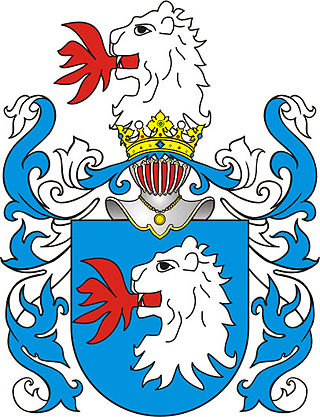
Stanislovas Jonavičius Kęsgaila was a Lithuanian nobleman, son of Jonas Kęsgaila from the Kęsgaila family. Stanislovas Kęsgaila was the Elder of Samogitia (1486–1522), Grand Hetman of Lithuania (1501–1502), castellan of Trakai (1499–1522) and Vilnius (1522–1526).
Stanislovas Svetkus Rapolionis was a Lutheran activist and Protestant reformer from the Grand Duchy of Lithuania. With patronage of Albert, Duke of Prussia, he obtained the doctorate of theology from the Protestant University of Wittenberg where he studied under Martin Luther and Philip Melanchthon. After graduation, he became the first professor of theology at the newly established University of Königsberg, also known as Albertina. As professor he began working on several Protestant publications and translations, including a Bible translation into Polish. It is believed that he also started the first translation of the Bible into Lithuanian. Together with Abraomas Kulvietis, Rapolionis was one of the first authors to write in the Lithuanian language. While Rapolionis and Kulvietis died early leaving their work unfinished, they laid the foundations for future Lithuanian writers and translators.

The House of Mindaugas was the first royal family of Grand Duchy of Lithuania, centered on Mindaugas, the first known and undoubted sovereign of Lithuania. He was crowned as King of Lithuania in 1253 and assassinated ten years later. His known family relations end with children; there is no data on his great-grandchildren or any relations with the Gediminids, a dynasty of sovereigns of Lithuania and Poland that started with Butigeidis ca. 1285 and ended with Sigismund II Augustus in 1572.

The family of Gediminas is a group of family members of Gediminas, Grand Duke of Lithuania, who interacted in the 14th century. The family included the siblings, children, and grandchildren of the Grand Duke and played the pivotal role in the history of Lithuania for the period as the Lithuanian nobility had not yet acquired its influence. Gediminas was also the forefather of the Gediminid dynasty, which ruled the Grand Duchy of Lithuania from 1310s or 1280s to 1572.
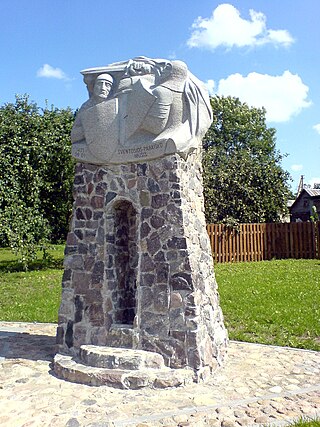
The Lithuanian Civil War of 1432–1438 was a war of succession to the throne of the Grand Duchy of Lithuania, after Vytautas the Great died in 1430 without leaving an heir. The war was fought on the one side by Švitrigaila, allied with the Teutonic Knights, and on the other by Sigismund Kęstutaitis, backed by the Kingdom of Poland. The war threatened to sever the Union of Krewo, the personal union between Poland and Lithuania. Švitrigaila's alliance with the Grand Master of the Teutonic Order, Paul von Rusdorf, launched the Polish–Teutonic War (1431–1435) but failed to secure victory for Švitrigaila.
Lengvenis was one of the local dukes in the early Grand Duchy of Lithuania during the reign of King Mindaugas (1230s–1263). First mentioned in 1242, Lengvenis was a nephew of Mindaugas.
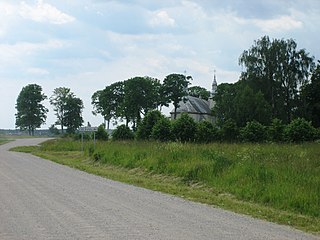
Šešuoliai is a small town in central Lithuania. It is located just east of the Lake Šešuoliai. According to the Lithuanian census of 2011, it had 138 residents. The town's central square and street layout is protected as an urban monument.
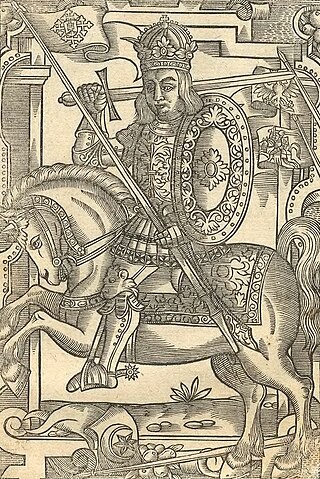
Mindaugas was the first known grand duke of Lithuania and the only crowned king of Lithuania. Little is known of his origins, early life, or rise to power; he is mentioned in a 1219 treaty as an elder duke, and in 1236 as the leader of all the Lithuanians. The contemporary and modern sources discussing his ascent mention strategic marriages along with banishment or murder of his rivals. He extended his domain into regions southeast of Lithuania proper during the 1230s and 1240s. In 1250 or 1251, during the course of internal power struggles, he was baptised as a Roman Catholic; this action enabled him to establish an alliance with the Livonian Order, a long-standing antagonist of the Lithuanians. By 1245, Mindaugas was already being referred to as "the highest king" in certain documents. During the summer of 1253, he was crowned king, ruling between 300,000 and 400,000 subjects, and got nicknamed as Mindaugas the Sapient by the Livonians.
The history of Lithuania between 1219 and 1295 concerns the establishment and early history of the first Lithuanian state, the Grand Duchy of Lithuania. The beginning of the 13th century marks the end of the prehistory of Lithuania. From this point on the history of Lithuania is recorded in chronicles, treaties, and other written documents. In 1219, 21 Lithuanian dukes signed a peace treaty with Galicia–Volhynia. This event is widely accepted as the first proof that the Baltic tribes were uniting and consolidating. Despite continuous warfare with two Christian orders, the Livonian Order and the Teutonic Knights, the Grand Duchy of Lithuania was established and gained some control over the lands of Black Ruthenia, Polatsk, Minsk, and other territories east of modern-day Lithuania that had become weak and vulnerable after the collapse of Kievan Rus'.
Die Littauischen Wegeberichte is a compilation of 100 routes into the western Grand Duchy of Lithuania prepared by the Teutonic Knights in 1384–1402. The Knights waged the Lithuanian Crusade to convert pagan Lithuanians into Christianity since the 1280s. The crusade was characterized with frequent raids into the enemy territory to loot and pillage. Since Lithuania lacked a developed road network, local Lithuanian and Prussian scouts would describe and document the best and most effective routes for the military raids into Lithuania.
The Battle of Memel was fought between the Samogitians and the Livonian Order in 1257 near Memel.
The Battle of the Vikhra River took place on 29 April 1386 on the Vikhra River, tributary of the Sozh River, near Mstislavl between the Grand Duchy of Lithuania and the Principality of Smolensk. The Lithuanians achieved a decisive victory and Smolensk was forced to accept being a vassal of Lithuania.
Tėvynės sargas was a Lithuanian-language periodical first established in 1896 in Tilsit, East Prussia during the Lithuanian press ban and the Lithuanian National Revival. It was published by the clergy and later by the Christian Democrats, thus it reflected and advocated for Roman Catholic ideals and values. Its motto was "All for Lithuania, Lithuania for Christ". With interruptions, it was published until 2000.
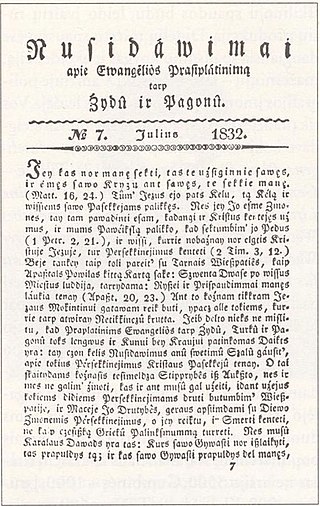
Nusidavimai apie evangelijos prasiplatinimą tarp žydų ir pagonių was the second Lithuanian-language periodical. It was published from 1832 to August 1914 in Königsberg, East Prussia, by the Evangelical Missionary Society of Königsberg and mainly reported on Evangelical missions in Asia, Africa, South America. It was discontinued due to the outbreak of World War I.

Videniškiai is a historic village in the Molėtai District Municipality, Lithuania. It is located about 8 kilometres (5.0 mi) west of Molėtai. It is situated between the Ukmergė–Molėtai road and the Siesartis River. According to the 2011 census, it had 368 residents. In the 16th–17th centuries, the village was one of the core properties of the Giedroyć family who funded the monastery for the Canons Regular of Penitence of the Blessed Martyrs and the Church of St. Lawrence. The monastery honored Michał Giedroyć who was possibly born in the village and was officially beatified in 2018. The reconstructed monastery now houses a small museum and a library.

Pėdžiai is a village in Kėdainiai district municipality, in Kaunas County, in central Lithuania. According to the 2011 census, the village had a population of 80 people. It is located 2 kilometres (1.2 mi) from Nociūnai, by the Barupė river, between the roads "Jonava-Šeduva" (KK144) and A8. There is a cemetery and a pond.

Kūjėnai is a village in Kėdainiai district municipality, in Kaunas County, in central Lithuania. According to the 2011 census, the village had a population of 17 people. It is located 2 kilometres (1.2 mi) from Šventybrastis, nearby the Lančiūnava-Šventybrastis Forest.
References
- ↑ Bojtár, Endre (1999). Foreword to the Past: A Cultural History of the Baltic People. CEU Press. p. 123. ISBN 963-9116-42-4.
- 1 2 Čelkis, Tomas (2009). "Wartbergės kronika". Mažosios Lietuvos enciklopedija (in Lithuanian). Vol. 4. Vilnius: Mokslo ir enciklopedijų leidybos institutas. p. 803. ISBN 5-420-01470-X.
- 1 2 Batūra, Romas (1996). Baltų religijos ir mitologijos šaltiniai (PDF) (in Lithuanian). Vol. I. Vilnius: Mokslo ir enciklopedijų leidykla. pp. 417–418. ISBN 5420013533.
- ↑ Petrauskas, Rimvydas (2006). "Recenzija. Hermanni de Wartberge Chronicon Livoniae / Vartberges Hermana Livonijas hronika" (PDF). Lituanistica (in Lithuanian). 1 (65): 73–74. ISSN 0235-716X.[ permanent dead link ]